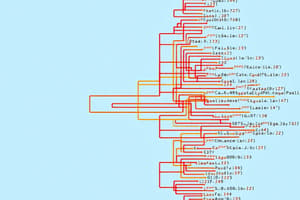Podcast
Questions and Answers
What is a binary search tree?
What is a binary search tree?
A binary search tree is a binary tree with the added property that the left child is less than the parent, which is less than or equal to the right child.
Where do we get our definition of a binary search tree?
Where do we get our definition of a binary search tree?
The definition of a binary search tree is an extension of the definition of a binary tree.
What references does a BinaryTreeNode object maintain?
What references does a BinaryTreeNode object maintain?
Each BinaryTreeNode object maintains a reference to the element stored at that node, as well as references to each of the node's children.
What must happen when an element in a binary search tree is removed?
What must happen when an element in a binary search tree is removed?
Where are the minimum and maximum elements in a binary search tree?
Where are the minimum and maximum elements in a binary search tree?
What is one use of a tree?
What is one use of a tree?
What could happen if a binary search tree is not balanced?
What could happen if a binary search tree is not balanced?
What is the height of the right subtree minus the height of the left subtree called?
What is the height of the right subtree minus the height of the left subtree called?
What are the ways a tree or subtree can become unbalanced?
What are the ways a tree or subtree can become unbalanced?
Is the balance restriction on red/black trees more strict than the balance restriction on AVL trees?
Is the balance restriction on red/black trees more strict than the balance restriction on AVL trees?
What is a binary search tree?
What is a binary search tree?
What is the term used to describe a node in a tree being moved up to replace a parent node?
What is the term used to describe a node in a tree being moved up to replace a parent node?
What is a degenerate tree?
What is a degenerate tree?
What is a right rotation?
What is a right rotation?
What is a left rotation?
What is a left rotation?
What is a right-left rotation?
What is a right-left rotation?
What is a left-right rotation?
What is a left-right rotation?
What are AVL trees?
What are AVL trees?
What is the balance factor?
What is the balance factor?
What are red/black trees?
What are red/black trees?
What is the difference between a binary tree and a binary search tree?
What is the difference between a binary tree and a binary search tree?
Why are we able to specify addElement and removeElement operations for a binary search tree but not for a binary tree?
Why are we able to specify addElement and removeElement operations for a binary search tree but not for a binary tree?
Flashcards are hidden until you start studying
Study Notes
Binary Search Trees Overview
- A binary search tree (BST) allows for efficient searching and sorting by structuring the tree such that the left child is less than the parent, and the parent is less than or equal to the right child.
- The definition of a BST builds on the foundational concept of a binary tree, emphasizing the ordering property.
BinaryTreeNode Structure
- Each
BinaryTreeNodemaintains references to the element it stores and its left and right children.
Node Removal in BSTs
- When removing an element from a BST, it’s necessary to promote another node to replace the removed node, maintaining the tree's properties.
Locating Extremes
- The minimum element in a BST is found at the leftmost node, while the maximum element is at the rightmost node.
Tree Efficiency and Balance
- Trees are widely used to implement efficient data structures for collections.
- An unbalanced BST can degrade performance, making operations less efficient than those in linear structures.
Balance Factor and Tree Balance
- The balance factor of a node is calculated by subtracting the height of the left subtree from the height of the right subtree; a balance factor outside the range of -1 to 1 indicates an unbalanced tree.
- A tree can become unbalanced primarily through the insertion or deletion of nodes.
Tree Balancing Techniques
- Red/black trees and AVL trees are strategies used to keep BSTs balanced, though red/black trees have a less strict balancing requirement than AVL trees.
- In both trees, the find operation complexity is O(log n).
Types of Rotations for Rebalancing
- Right rotation is employed when the long path is within the left subtree of the left child.
- Left rotation is applied when the long path is in the right subtree of the right child.
- Right-left rotation is a double rotation strategy for balancing involving the left child of the right subtree.
- Left-right rotation is a double rotation strategy for balancing involving the right child of the left subtree.
AVL and Red/Black Trees
- AVL trees maintain balance using the balance factor of each node, ensuring the tree remains balanced after operations.
- Red/black trees utilize a color property for balance, assigning either red or black to each node to facilitate rebalancing.
Conceptual Differences
- A key distinction between binary trees and binary search trees is the ordering of node values, which is crucial for the operations of addElement and removeElement in a BST, not available in a general binary tree structure.
Studying That Suits You
Use AI to generate personalized quizzes and flashcards to suit your learning preferences.




